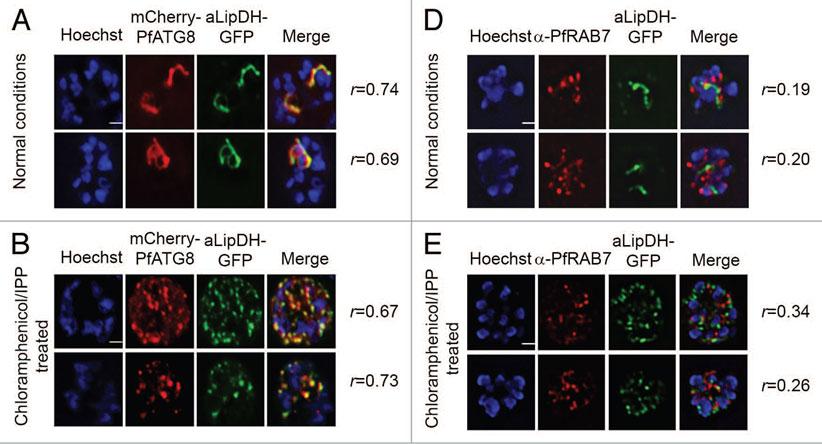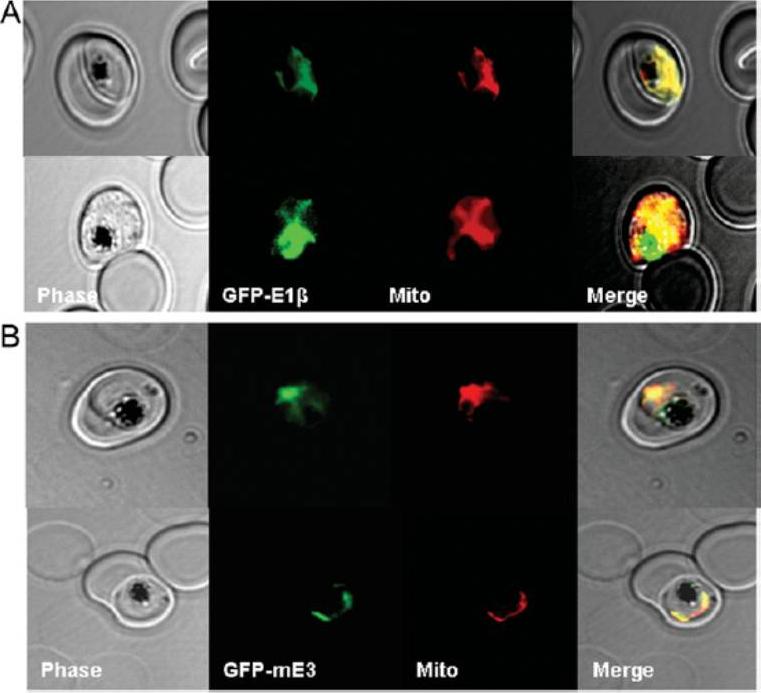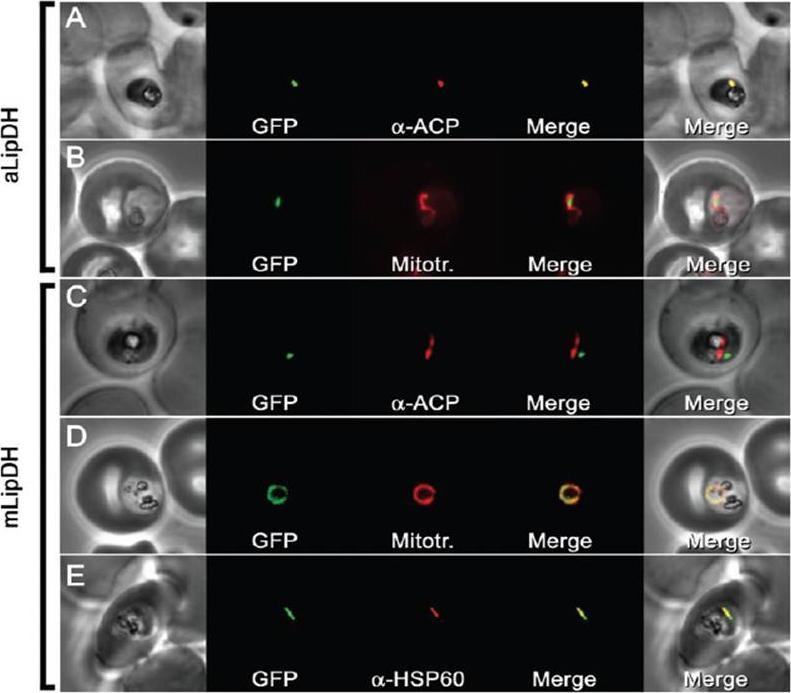PF3D7_1232200 dihydrolipoyl dehydrogenase, mitochondrial (LPD1)
Disruptability [+]
| Species | Disruptability | Reference | Submitter | |
|---|---|---|---|---|
| P. falciparum 3D7 |
Refractory |
USF piggyBac screen (Insert. mut.) | USF PiggyBac Screen | |
| P. berghei ANKA |
Possible |
PlasmoGEM (Barseq) | PlasmoGEM | |
Mutant phenotypes [+]
| Species | Stage | Phenotype | Reference | Submitter |
|---|---|---|---|---|
| P. berghei ANKA | Asexual |
Attenuated |
PlasmoGEM (Barseq) | PlasmoGEM |
Imaging data (from Malaria Metabolic Pathways)

PfATG8, but not PfRAB7, colocalizes with apicoplast-targeted vesicles and apicoplast remnants. (A and B) P. falciparum expressing both mCherry-PfATG8 and aLipDH-GFP (lipoamide dehydrogenase) were treated with chloramphenicol to chemically disrupt the formation of the apicoplast, and IPP added to the culture medium to maintain viability of the parasites. DMSO control (A) and chloramphenicol treated (B) infected erythrocytes were counterstained with Hoechst 33258. The Pearson’s coefficients (r) show the degree of colocalization in each individual image. (D and E) Transgenic parasites expressing aLipDH-GFP were treated as above. Immunofluorescence analyses of untreated controls (D) or chloramphenicol/IPP treated (E) and were performed using anti-PfRAB7 antibodies (red). Hoechst 33258 (blue) was used to stain the nuclei. Scale bar: 2 μm.Tomlins AM, Ben-Rached F, Williams RA, Proto WR, Coppens I, Ruch U, Gilberger TW, Coombs GH, Mottram JC, Müller S, Langsley G. Plasmodium falciparum ATG8 implicated in both autophagy and apicoplast formation. Autophagy. 2013 Aug 29;9(10). PMID: 2402567
See original on MMP
Localization of components of the mitochondrial branched chain KADH complexes. The localization of the E1β-subunit of P. falciparum BCKDH complex and the mitochondrial lipoamide dehydrogenase were analysed by expressing the first 390 and 653 nucleotides respectively tagged with GFP in erythrocytic stages of the parasite. (A) E1β-subunit of BCKDH. Phase, phase contrast image; GFP–E1β, image obtained with GFP channel; Mito, image obtained with rhodamine channel representing the localization of MitoTracker CMred; Merge, merged image. (B) Mitochondrial lipoamide dehydrogenase. Phase, phase-contrast image; GFP–mE3, image obtained with GFP channel; Mito, image obtained with rhodamine channel representing the localization of MitoTracker CMred; Merge, merged image.Günther S, McMillan PJ, Wallace LJ, Müller S. Plasmodium falciparum possesses organelle-specific alpha-keto acid dehydrogenase complexes and lipoylation pathways. Biochem Soc Trans. 2005 33:977-80.
See original on MMP
Localization of apicoplast and mitochondrial LipDH. The localization of aLipDH and mLipDH was investigated by expressing the putative N-terminal presequences fused to GFP in P. falciparum intraerythrocytic parasites. A and B. Colocalization with antibodies directed against the apicoplast-resident acyl-carrier protein PFB0385w (ACP; A) and with MitoTracker Red (B) demonstrates that the putative apicoplast targeting presequence of aLipDH targets the marker protein GFP exclusively to the apicoplast. C–E. Colocalization experiments with the apicoplast protein ACP (C) and with the two mitochondrial markers MitoTracker Red and HSP60 PF10_0153 (D and E) indicate that mLipDH is localized exclusively in the mitochondrion.McMillan PJ, Stimmler LM, Foth BJ, McFadden GI, Müller S. The human malaria parasite Plasmodium falciparum possesses two distinct dihydrolipoamide dehydrogenases. Mol Microbiol. 2005 55:27-38. Copyright John Wiley & Sons Ltd. 2010.
See original on MMPMore information
| PlasmoDB | PF3D7_1232200 |
| GeneDB | PF3D7_1232200 |
| Malaria Metabolic Pathways | Localisation images Pathways mapped to |
| Previous ID(s) | 2277.t00310, MAL12P1.310, PFL1550w |
| Orthologs | PBANKA_1446900 , PCHAS_1449100 , PKNH_1451700 , PVP01_1450400 , PVX_100555 , PY17X_1449400 |
| Google Scholar | Search for all mentions of this gene |